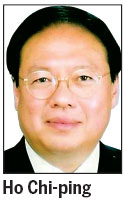Singapore's green landfill solution
Updated: 2013-07-17 06:20
By Ho Chi-ping(HK Edition)
|
|||||||||
Because landfills are a subject on everyone's lips, during a recent visit to Singapore I sought updates from senior government officials on a remarkable project there that has interested me for some years - the Pulau Semakau landfill site that plays a key role in the island republic's pace-setting environmental initiatives.
The officials were surprised when I told them that Hong Kong still depended solely on landfills, and could scarcely believe that we did not have a battery of incinerator plants to burn our combustible trash 24/7 and so enjoy a never-ending supply of energy from the heat that this process generates.

There are many similarities between Hong Kong and Singapore, and many common problems, too. Since it is only common sense that we learn from each other, I strongly recommend that Hong Kong's environmental authorities pay a look-and-learn visit to Singapore to see some of the solutions they employ to cope with their equally massive waste disposal problems. It should be noted that Singapore is not averse to copying the best ideas of Hong Kong, one example being the Mass Rapid Transit underground rail system it opened in 1987 - eight years after our own pace-setting MTR showed them the way.
Meanwhile, Semakau is the world's first ecologically designed landfill island, and is gradually being filled mainly with ash from Singapore's four incinerator plants. It is 8 km off the coast, covers 350 hectares and has an enormous capacity - no less than 63 million cubic meters. As an example of its capacity it is forecast to continue until 2040.
For centuries there had been two adjoining islands on the site, Semakau and Sakeng, and between them they housed several fishing villages. The fisherfolk's idyllic lifestyle (except during storms) would be continuing undisturbed today if Singapore hadn't grown prosperous from tourism and trade after World War II. Environmental studies in the 1990s showed that wealthy Singaporeans were spending far more freely - and as a result were throwing away about six times more household trash than in 1970. Since land in Singapore is arguably even more precious than our land - its population of 4.2 million is squeezed into a mere 697 square kilometers - the island's comparatively small landfills were filling faster than anticipated, and so planners hit on the quite ingenious Semakau-Sakeng idea, which not only solves the island state's rubbish disposal problem, but creates much needed land in the process.
By comparison Hong Kong has a population of about 7,053,000 people occupying 1,054 sq km of land comprising more than 200 islands, most of them uninhabited - and no doubt some highly suitable for a carbon copy of Singapore's Semakau project.

Before the reclamation project could begin in 1999 to create a single much larger island, the fishermen and their families had to be re-housed on Singapore. That done, the $400 million reclamation began, the toughest job being the construction of a "super seawall" to serve as a buffer against the heavy waves constantly crashing against the otherwise unprotected eastern or "weather" side of the man-made island. The key to the strength of the 7-km seawall is an impermeable membrane reinforced with compacted marine clay and rock.
In 2005, after the first sections of the landfill were completed, Semakau was thrown open to the public for recreational visits. Day-trippers were delighted to find it was clean and odorless. They were greeted by swathes of greenery where plants, grasses and other vegetation had taken root and were flourishing. Birds were also found to have flocked to this new nesting site, while the waters on the calm side of the island were now alive with fish and other forms of marine life.
Semakau has now become a popular site for nature lovers, bird-watchers, picnickers, shutterbugs and weekend fishermen. Its attractions for nature lovers will grow when the landfill project is completed in 17 years. A 90-hectare ecological park will then be built that will become a test-bed for renewable and clean technologies using wind, solar and tidal power. Not only will these plants make Semakau self-sustaining for power, there will also be a desalinization station producing clean water for the park's greenery. Meanwhile, the main section of the completed landfill will be reserved for Singapore's land-use requirements.
Presently, this is how Singapore handles its waste: 60 percent is recycled; 37 percent is incinerated and 3 percent goes to Semakau. Environment Minister Vivian Balakrishnan says of their waste disposal program: "The day will come when we no longer have any landfills and we will have to recycle." It looks like something Hong Kong should also aim for, in which everybody - nature lovers, environmentalists, energy conservationists, the government, tax payers and citizens - stands to win. Balakrishnan shares a common interest with me in that we were both ophthalmic surgeons by training and specialized in treating diseases of the retina. However, from the perspective of environmental issues such as waste disposal, there seems to be more complications from short-sightedness among Hong Kong residents than their Singaporean counterparts.
The author is vice-chairman and secretary-general of the China Energy Fund Committee.
(HK Edition 07/17/2013 page9)